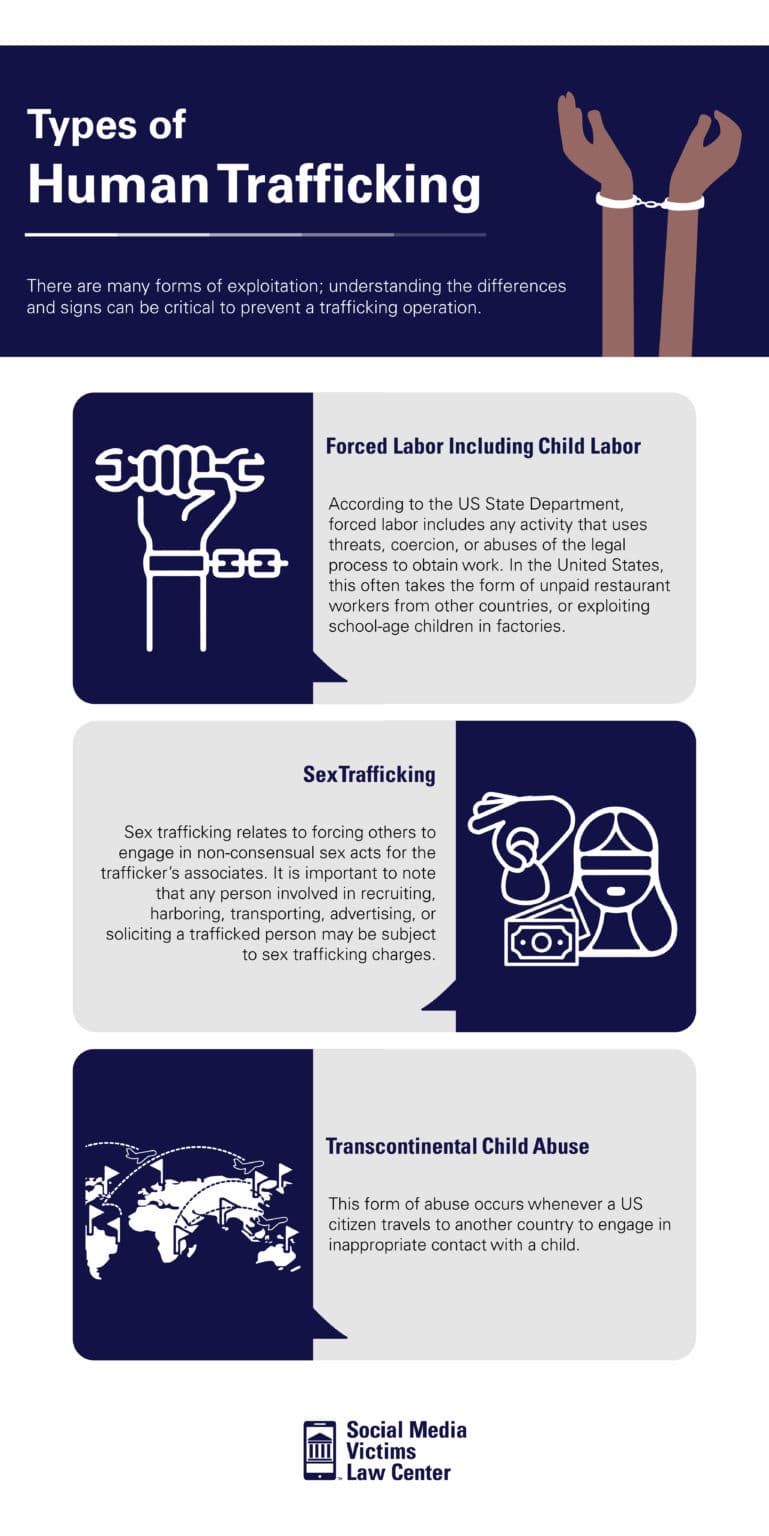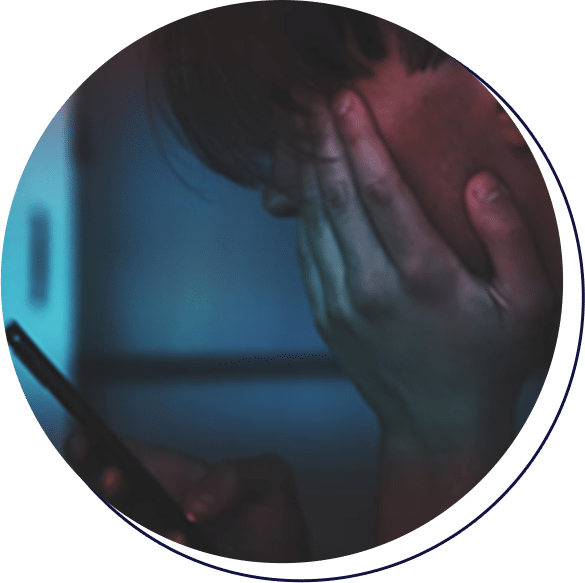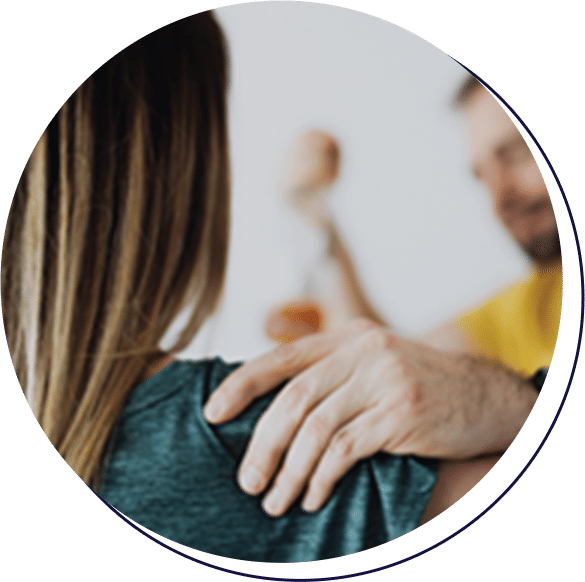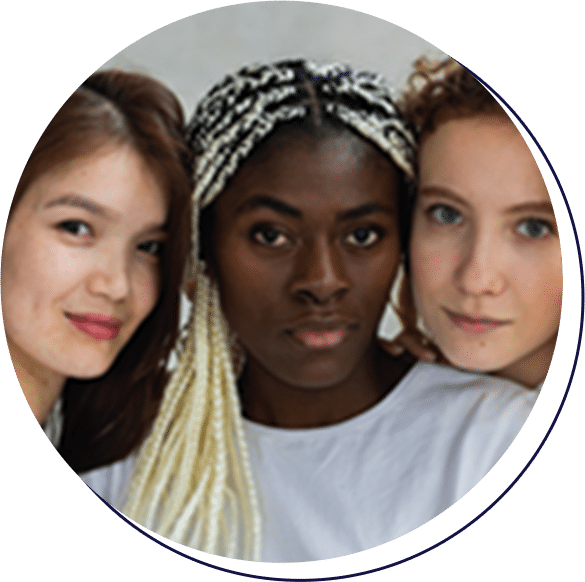Social Media and Human Trafficking

- Content last updated on:
- August 14, 2025
Written and edited by our team of expert legal content writers and reviewed and approved by

- Content last updated on:
- August 14, 2025
What You’ll Learn
- Human Trafficking Starts Early and Online
- Facebook’s Knowledge of Human Trafficking
- Human Trafficking is About Controlling Victims
- Types of Human Trafficking
- Current Laws Against Human Trafficking
- Recognizing When a Child is Being Trafficked
- Talking to Your Child About Human Trafficking and Social Media
Unfortunately, technology has made it easier for human traffickers to find potential victims. According to a 2018 report by Thorn, roughly 45% of victims indicated that they met the trafficker in person. The remaining 55% encountered the person via technology, including social media platforms, text messages, or deceptive websites.
A 2021 Polaris report using data from the National Human Trafficking Hotline identifies several troubling trends regarding the recruitment locations used by traffickers. Between 2019 and 2020, traditional recruitment sites such as bus stations, strip clubs, mental health facilities, and private foster homes all experienced significant declines. At the same time, Facebook experienced a 125% increase in trafficking recruitment. The nearly 95% increase only rivals that number in those using Instagram to find victims.
These numbers indicate a dangerous trend in how human traffickers find potential victims. With billions of people using these social media sites, it gives criminals easy access far beyond what was possible in decades past.
Human Trafficking Starts Early and Online
Current trafficking operations target online resources to identify and exploit victims. Because they can find at-risk victims without appearing in person, it is easier to prey on vulnerable children. Teachers or parents might notice a criminal hanging around public schools or family neighborhoods. However, with social media access and a smartphone, we have experienced a global rise in first contacts taking place online.
The Polaris report details that just over 27% of victims are are minors. However, only 8.8% are confirmed to have started as adults. That leaves a whopping 63.8% having entered unfavorable circumstances at an unknown age.
Around 17% of victims indicated that the first-time trafficker was a family member, and more than 80% of them were younger than 11 years old when the exploitation began. That could mean strict social media age restrictions are still missing one of the driving forces of youth victimization.
Facebook's Knowledge of Human Trafficking
Some of the most critical questions asked in recent months have been about the extent to which online social media platforms are responsible for the fate of trafficking victims. As an article in Psychology Today documented, social media accounts provide a significant opportunity for grooming potential victims.
A criminal may create fake social media accounts specifically to interact with school-aged children in this process. They may use the fake profiles to dialog online for months, pretending to have common interests and building trust.
An article on CBS News indicates that more than half of all online recruiting occurs on Facebook. By establishing an online relationship with the victim first, the traffickers can get people to walk into situations they would not usually accept with strangers. Unfortunately for advocates of victims’ rights, Facebook appeared to have ignored its role in enabling child trafficking. For this reason, many activists wish to hold the popular social media site accountable for its failure to protect trafficking victims.
Human Trafficking is About Controlling Victims
Human trafficking happens in several different forms, but it follows the same patterns. The Polaris Project offers an excellent breakdown of the various stages and elements of exploitative conditions. The trafficker recruits the victim in the first step, usually with a simple “job offer” or opportunity. Alternatively, they may recruit victims abroad with a “scholarship” to a U.S. university or hide their real identities behind a “catfish,” a fake profile meant to deceive the victim.
After the first meeting, the grooming stage takes place. The trafficker cultivates a positive relationship with the potential victim during this stage. Catfish “love interests” may shower a young girl with gifts for being “beautiful.” Fake school recruiters may conduct interviews with a potential student about career choices, or offer to pay for travel and relocation costs.
The third stage of the process is trafficking and control. It is here that the intended victim finally realizes the truth. The criminal now uses threats of violence, withholds necessary resources, and engages in explicit acts of abuse to keep the victims in their control.
Victims transported to other countries may also have a language barrier preventing them from seeking help. If the victims are fortunate enough to escape this precarious, toxic situation, the final stage is the exit and healing process.
Types of Human Trafficking
There are many forms of exploitation; understanding the differences and signs can be critical to prevent a trafficking operation.
Forced Labor Including Child Labor
According to the US State Department, forced labor includes any activity that uses threats, coercion, or abuses of the legal process to obtain work. In the United States, this often takes the form of unpaid restaurant workers from other countries, or exploiting school-age children in factories.
Sex Trafficking
Sex trafficking relates to forcing others to engage in non-consensual sex acts for the trafficker’s associates. It is important to note that any person involved in recruiting, harboring, transporting, advertising, or soliciting a trafficked person may be subject to sex trafficking charges.
Transcontinental Child Abuse
This form of abuse occurs whenever a US citizen travels to another country to engage in inappropriate contact with a child.

Current Laws Against Human Trafficking
In case there was any doubt, in most cases, human trafficking actions are explicitly criminal offenses, not civil. Law enforcement agencies often find uncovering and prosecuting such operations difficult because they occur outside the public’s awareness. However, there are still anti-trafficking laws being enforced every day.
The Trafficking Victims Protection Act was passed nationally in 2000 and authorized the expenditure of federal resources to combat slavery, involuntary servitude, and the sex trade. In 2018, the FOSTA-SESTA bill was passed to prosecute online marketplaces for knowingly facilitating sex trafficking.
Victim advocates continue to study national and international law for new opportunities to stem the tide of human trafficking. Advances in technology since 2000 may eventually require new legislation to address the use of digital technology.
Recognizing When a Child is Being Trafficked
One of the most practical steps everyday people can take to curtail human trafficking is learning the signs of a trafficking situation. The FBI, local law enforcement, and victim advocates need this information to pursue potential cases. The first thing to understand is that young people who have low self-esteem, are abused, are homeless, or in a foster home may face greater risk.
According to UNICEF, Here are a few other signals to notice:
- Children working long hours, incongruently to child labor laws
- Young people who have inconsistencies when asked about their background
- Victims may be hired under false pretenses and exhibit visible anxiety about their situation
Perhaps more importantly, be aware of circumstances and willing to ask questions when things don’t add up. If human traffickers or other unsafe conditions are present, contact law enforcement directly to report the situation.
Talking to Your Child About Human Trafficking and Social Media
As with many other situations, communication is one of a parents’ most comprehensive tools against human trafficking. It is crucial to have open and honest conversations with children to help them understand the dangers of social media.
Children should know never to share personal information, including name and address, with strangers they meet online. Kids should also recognize that it is possible to create fake profiles, so they may not be sending messages with a person matching the picture.
Parents or guardians should warn children about accepting friend requests from people they do not know. Traffickers frequently create false profiles to lure potential victims. It is also essential to be aware of duplication accounts, as they may also belong to scammers or criminals.
Perhaps most importantly, never meet a person you met online without discussing the matter with an adult. Even if they have been dialoguing online with a person for months or years, young people must understand that it can still be a trap. Finally, if they end up in a bad situation, make sure they know to leave the situation as soon as they feel unsafe.
If you believe your child has already been harmed by the effects of social media, please contact us for a free consultation.
Frequently Asked Questions
For individuals and children who have been
We only handle cases on a contingent fee basis. This means that we are paid a portion of any recovery obtained in the case and you do not owe us any attorneys’ fees if the lawsuit does not result in a recovery.
Every case is unique. Our attorneys will work with your family to evaluate your potential case and help you evaluate whether filing a lawsuit or other legal proceeding is in your family’s best interest. Generally speaking, the types of cases we handle involve serious mental health effects, including attempted or completed suicide, eating disorders, inpatient mental health treatment, or sexual trafficking/exploitation that was caused by or contributed to through addictive or problematic social media use by teens and young adults.
We are a law firm based near Seattle, WA comprised of lawyers who have spent their entire careers representing victims who have been harmed by dangerous products. We are also parents. Shocked and troubled by the recent revelations about the harm caused to teens and young adults by social media platforms, which powerful technology companies have designed to be highly addictive, Social Media Victims Law Center was launched specifically to help families and children who have suffered serious mental harm or exploitation through social media use to obtain justice.
Contact Us Today
Related Pages
Client Testimonials
Explore Popular Topics

Addiction

Suicide

Eating Disorders

Anxiety

Bullying

Sexual Abuse

Body Image

